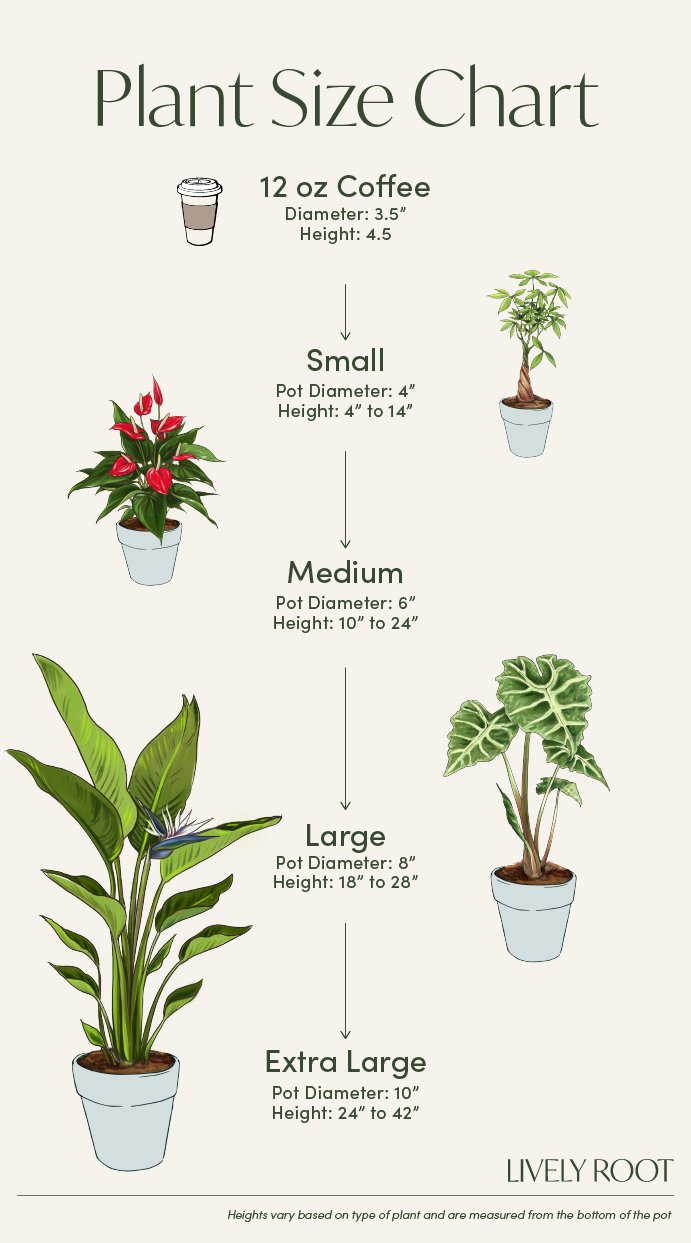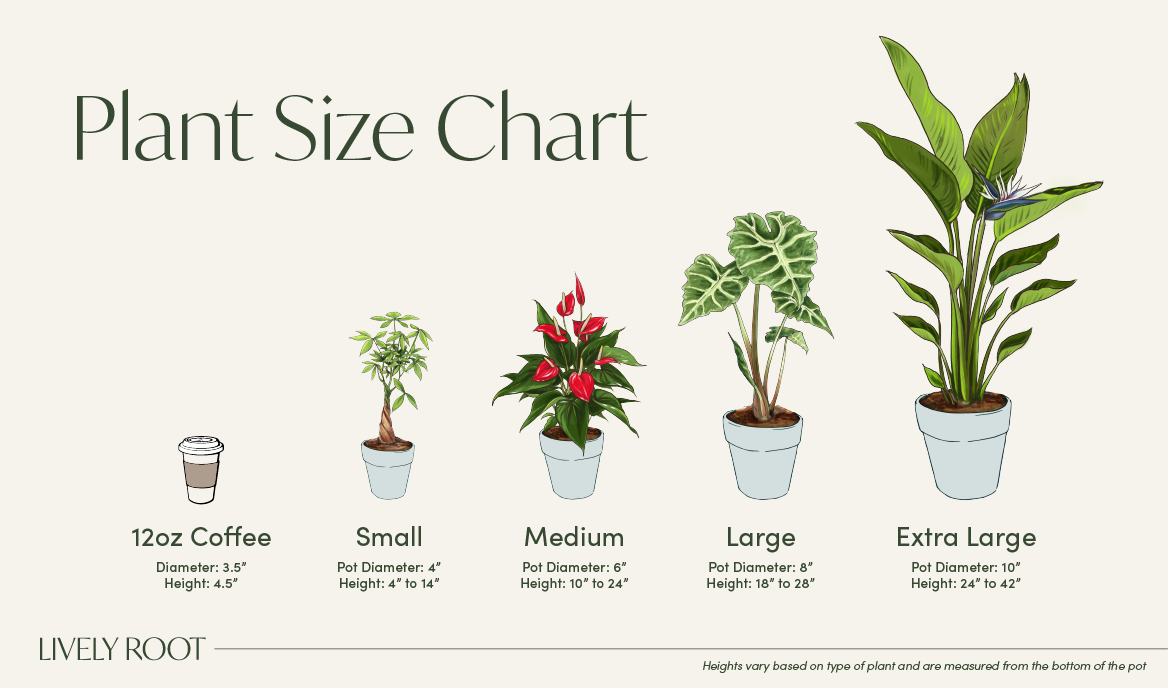

Meet the lush Ponytail Palm that will add a quirky touch to any room. These palm trees have thin, curly leaves that gently tumble down past their thick stalk. Although they look utterly whimsical, they are actually low maintenance and one of our favorite starter plants. The Ponytail Palm tree enjoys direct sunlight and can live on your patio if you live in USDA hardiness zones 9 through 11.
Ponytail Palm Care & Buying Guide

Enjoys full sun or partial shade outside, or bright light inside.
Water well when received, then allow the soil to dry out between waterings.
Doesn't require high levels of humidity.
Keep this plant in rooms where the temperature is a comfortable 70°F-80°F and avoid cold drafts or air vents below 50°F.
Outside: Keep them in full sun (6-8 hours) on a patio where nights are above 50°F.
Apply a balanced, liquid fertilizer especially formulated for indoor plants every month.
When receiving the Ponytail Palm, do not repot immediately but wait at least 6-12 months or if the roots are beginning to get crowded and growing through the drainage holes.
Repot in the spring, using a 2 inches bigger pot to keep the roots drier. (Too big of a planter could cause the soil to dry slower.) We suggest using a taller container so the pretty tips of the leaves can dangle over the edges without hitting the table surface.
Place a piece of screening at the bottom of the container over the drainage hole to secure the soil and allow to drain. Use a well-draining indoor potting mix with perlite to help with drainage.
Water your plant in the old pot before transferring over and let sit an hour.
Add well-draining interior potting (cacti and succulent) soil to the bottom to elevate the root ball. Lift the plant and release the roots against the existing planter. Use a clean knife or garden trowel to wedge between the pot and the soil to loosen.
Inspect the root ball. Notice if there are any dead or rotting roots and trim off with sterile pruners. If the plant is rootbound, loosen the roots to alleviate continued encircling.
Ensure the plant is sitting about 1 inch below the edge of the pot to avoid water spillage. Add more soil and backfill around the sides by tamping down. Fill up to the soil line but not over.
Water thoroughly, leaving the soil damp but not soggy. If settling occurs, add more soil but do not cover the trunk above the surface.
Water well to dampen the soil and let drain.
When watering your Ponytail Palm, it is an excellent time to trim off any browning, yellowing, or discolored leaves or tips. When pruning, use clean, sharp pruners. Remove any debris from the soil and replenish if needed.
To clean debris and dust off the leaves:
Place the Ponytail Palm in a shower or tub.
Fill a watering can with a shower spout with filtered, bottled, or water free of chlorine and fluoride.
Shower the leaves, to clear off dust and dirt.
Let the water drain and replace your plant in the decorative container.
To propagate a Ponytail Palm divide the shoots from the parent plant. This is best done in the Spring. Water the plant to hydrate the plant the night before. Remove the soil around the trunk of the plant and base of the shoots. Dig deep to ensure the shoots have established enough roots to divide. The shoots or pups should be at least five inches tall. Do not disturb the mother plant.
Using a sharp knife to cut the shoot while keeping in tack the detached portions fibrous roots. Repair and add soil around the parent plant.
Plant the offshoot into a well-draining soilless mix such as a succulent and cacti mix or a sand-based potting soil. Amend the mix with a rooting hormone to help prevent transplant shock. Use a container two inches wider than the root base. Place the new plant so the top layer of soil is an inch below the top edge of the container to prevent water spillage.
Water well after securing the soil around the roots. Place a clear, plastic bag over the planter to keep humidity high and mist the inside of the bag. Place the planter in a warm, bright to moderate indirect light to root. Water approximately every two weeks and keep misting the plant and soil surface as they establishe. After the roots establish, the plastic can be removed.
Ponytail Palm: Overview
The Ponytail Palm (Beaucarnea recurvata) is a stunning tropical plant with curly, thin fronds and a thick trunk. This beautiful palm tree belongs to the Asparagaceae family and originates from the desert regions of Mexico. It can reach 6-8ft as an indoor plant but grows very slowly. The Ponytail palm is suitable for growing outdoors in hardiness zones 9-11. It’s a sun-loving plant that enjoys direct light and low humidity.
The Ponytail palm tree is an easy-care plant, adaptable and resilient to dry conditions. It’s suitable for novice plant enthusiasts or busy folks. In addition, the Ponytail Palm is non-toxic to cats and dogs. In Feng Shui, the Ponytail Palm Tree symbolizes growth, resilience, and vitality.
Ponytail Palm: Benefits
- Easy-care plant with exotic appeal
- Non-toxic to cats and dogs
- A natural air purifier
- Perfect floor plant in interior spaces
- Boosts property’s curb appeal
- A great landscaping plant for hot and dry climates
Ponytail Palm Care Guide
The Ponytail Palm is a tropical plant that thrives in full sun and prefers dry conditions. This pet-friendly plant is low-maintenance and adapts well to indoor environments. Here is how to care for a Ponytail Palm:
Watering and Humidity
Water your Ponytail palms when the topsoil is dry. Avoid overwatering this palm tree to prevent waterlogging, which can lead to root and leaf issues. Good beaucarnea recurvata care includes proper drainage, so ensure the pot has enough drainage holes. Ponytail palms thrive in low humidity, as they are desert plants.
Light and Temperature
Ensure your Ponytail Palm plant receives a few hours of direct sunlight. You can place it in a sunroom, on a sunny patio, or near a south- or west-facing window. The Ponytail Palm thrives in warm temperatures, ranging between 70℉ and 80℉. Keep it away from cold drafts.
Soil, Repotting, and Fertilizing
Ponytail Palms grow best in well-draining potting mix. Feed your plant with a balanced fertilizer in the growing season. Repot your Ponytail Palm every 2-3 years. Use a pot with enough drainage holes, which is 2 inches larger than the previous one.
Propagation
Propagate your Ponytail palm by division. Water the plant and separate the shoots from the mother plant with a clean knife. Ensure the pups are at least 5 inches long and have a strong root system. Plant them in a well-draining soil with added root hormone. Place the pots near a sunny window.
Pruning, Cleaning, and Common Issues
Trim off damaged leaves for a tidier appearance, and clean the dust with a damp cloth. The most common issue with this palm variety is overwatering, which leads to root rot and browning leaves. Cold temperatures can also harm your plant. The good news is that Ponytail palms rarely suffer from pest infestations
Ponytail Palm Plant: Placement, Companion & Alternative Plants
The stunning Ponytail palm is the perfect statement plant in any home or office. It makes a wonderful gift for friends and family.
Best Locations & Uses
- Beautiful large plant for spacious rooms
- Perfect for novice indoor gardeners
- Ideal plant for plant enthusiasts with pets
- Can be grown outdoors in warm and dry climates
Companion Plants
Looking for the ideal companion plants for your Ponytail plant? See below some of our suggestions:
- ZZ Plant (Zamioculcas zamiifolia): The low-maintenance ZZ Plant adapts well to various conditions, making it ideal for people new to plant care.
- Calathea Rattlesnake (Calathea lancifolia): The Rattlesnake plant boasts a striking pattern on its foliage; this rare beauty thrives in medium light and high humidity.
- Golden Pothos Plant (Epipremnum aureum): The Golden Pothos has many benefits, including a tolerance to low light, resilience, adaptability, and strong air-purifying properties.
Alternative Plants
Here are 3 beautiful and low-maintenance alternatives to the Ponytail Palm:
- Cat Palm (Chamaedorea cataractarum): The Cat Palm is a gorgeous palm tree that is easy to care for and pet-safe, making it perfect for plant lovers with pets.
- Neanthe Bella Palm (Chamaedorea elegans): The pet-friendly and air-purifying Neanthe Bella Palm will add a tropical vibe to any indoor and outdoor space.
- Areca Palm (Dyptis lutescens): The much-loved and pet-safe Areca Palm has lush green fronds and is the perfect statement plant for your living room.
Ponytail Palm: FAQs
Q: What is the life expectancy of a ponytail palm?
A: The Ponytail Palm can live for decades in its natural habitat. Indoors, it can stay healthy and happy for at least 20 years.
Q: What is the lowest temperature a ponytail palm can tolerate?
A: Avoid temperatures below 50℉, although your Ponytail Palm can survive short periods in 40℉. If grown as a potted plant outdoors, it’s best to bring it inside in cooler weather.
Q: Should I cut the brown tips off my Ponytail Palm?
A: Trim the brown tips with clean scissors to improve your Ponytail Palm’s look.
Q: Where is the best place to plant a ponytail palm?
A: As a full-sun plant, the Ponytail Palm should be planted in a spot that receives direct sunlight. Indoors, place the pot near a sunny south- or west-facing window.
Shop the Exotic Ponytail Palm for Sale From Lively Root Now
Elevate your interior with the stunning Ponytail Palm from Lively Root, and add elegance and style to your space!




























































































